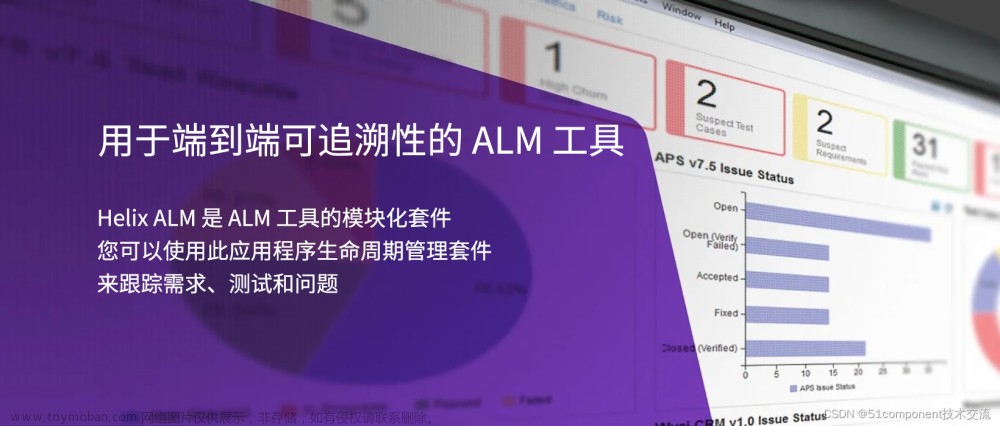Helm
-
什么是 Helm
-
安装 Helm
-
重要概念
-
使用 Helm
1 简介
官网地址: Helm
Helm是一个Kubernetes应用程序包管理工具,它允许你轻松管理和部署Kubernetes应用程序。Helm通过使用称为Charts的预定义模板来简化Kubernetes应用程序的部署和管理。Chart包含了一组Kubernetes对象定义,可以描述一个应用程序的完整部署和资源需求,包括Deployment、Service、ConfigMap、Secret等。使用Helm,你可以轻松地安装、升级、卸载和回滚Kubernetes应用程序。
同时,Helm还提供了一些便捷的功能,如依赖管理、全局变量、条件渲染等,可以帮助你更好地管理应用程序的部署。Helm有两个主要的组件:Helm客户端(helm)和Helm服务器(Tiller)。Helm客户端可以在本地运行,而Tiller则运行在Kubernetes集群中,并负责将Charts转换为Kubernetes对象。
2 安装
下载地址: Releases · helm/helm · GitHub
每个Helm 版本都提供了各种操作系统的二进制版本,这些版本可以手动下载和安装。
-
下载 需要的版本
-
解压(
tar -zxvf helm-v3.0.0-linux-amd64.tar.gz) -
在解压目录中找到
helm程序,移动到需要的目录中(mv linux-amd64/helm /usr/local/bin/helm) -
添加仓库: helm repo add bitnami https://charts.bitnami.com/bitnami
-
验证安装:
helm help.
3 重要概念
-
Chart 代表着 Helm 包。它包含在 Kubernetes 集群内部运行应用程序,工具或服务所需的所有资源定义。你可以把它看作是 Homebrew formula,Apt dpkg,或 Yum RPM 在Kubernetes 中的等价物。
-
Repository(仓库) 是用来存放和共享 charts 的地方。它就像 Perl 的 CPAN 档案库网络 或是 Fedora 的 软件包仓库,只不过它是供 Kubernetes 包所使用的。
-
Release 是运行在 Kubernetes 集群中的 chart 的实例。一个 chart 通常可以在同一个集群中安装多次。每一次安装都会创建一个新的 release。以 MySQL chart为例,如果你想在你的集群中运行两个数据库,你可以安装该chart两次。每一个数据库都会拥有它自己的 release 和 release name。
4 使用
4.1 搜索 charts
Helm 自带一个强大的搜索命令,可以用来从两种来源中进行搜索:
-
helm search hub从 Artifact Hub 中查找并列出 helm charts。 Artifact Hub中存放了大量不同的仓库。 -
helm search repo从你添加(使用helm repo add)到本地 helm 客户端中的仓库中进行查找。该命令基于本地数据进行搜索,无需连接互联网。
4.2 安装
使用 helm install 命令来安装一个新的 helm 包。最简单的使用方法只需要传入两个参数:你命名的release名字和你想安装的chart的名称。
[root@k8s-node1 ~]# helm install nginx bitnami/nginx
NAME: nginx
LAST DEPLOYED: Wed Apr 5 07:18:04 2023
NAMESPACE: kube-system
STATUS: deployed
REVISION: 1
TEST SUITE: None
NOTES:
CHART NAME: nginx
CHART VERSION: 13.2.34
APP VERSION: 1.23.4
** Please be patient while the chart is being deployed **
NGINX can be accessed through the following DNS name from within your cluster:
nginx.kube-system.svc.cluster.local (port 80)
To access NGINX from outside the cluster, follow the steps below:
1. Get the NGINX URL by running these commands:
NOTE: It may take a few minutes for the LoadBalancer IP to be available.
Watch the status with: 'kubectl get svc --namespace kube-system -w nginx'
export SERVICE_PORT=$(kubectl get --namespace kube-system -o jsonpath="{.spec.ports[0].port}" services nginx)
export SERVICE_IP=$(kubectl get svc --namespace kube-system nginx -o jsonpath='{.status.loadBalancer.ingress[0].ip}')
echo "http://${SERVICE_IP}:${SERVICE_PORT}"注意: 安装chart时创建了一个新的 release 对象。上述发布被命名为
nginx。 (如果想让Helm生成一个名称,删除发布名称并使用--generate-name。)
helm 安装顺序: Helm | 使用Helm
4.3 查看列表
你可以通过 helm list 命令看到当前部署的所有 release:
[root@k8s-node1 ~]# helm list
NAME NAMESPACE REVISION UPDATED STATUS CHART APP VERSION
nginx kube-system 1 2023-04-05 07:34:48.421708425 -0400 EDT deployed nginx-13.2.34 1.23.4 4.3 查看状态
你可以使用 helm status 来追踪 release 的状态,或是重新读取配置信息:
[root@k8s-node1 ~]# helm status nginx
NAME: nginx
LAST DEPLOYED: Wed Apr 5 07:18:04 2023
NAMESPACE: kube-system
STATUS: deployed
REVISION: 1
TEST SUITE: None
NOTES:
CHART NAME: nginx
CHART VERSION: 13.2.34
APP VERSION: 1.23.4
** Please be patient while the chart is being deployed **
NGINX can be accessed through the following DNS name from within your cluster:
nginx.kube-system.svc.cluster.local (port 80)
To access NGINX from outside the cluster, follow the steps below:
1. Get the NGINX URL by running these commands:
NOTE: It may take a few minutes for the LoadBalancer IP to be available.
Watch the status with: 'kubectl get svc --namespace kube-system -w nginx'
export SERVICE_PORT=$(kubectl get --namespace kube-system -o jsonpath="{.spec.ports[0].port}" services nginx)
export SERVICE_IP=$(kubectl get svc --namespace kube-system nginx -o jsonpath='{.status.loadBalancer.ingress[0].ip}')
echo "http://${SERVICE_IP}:${SERVICE_PORT}"4.4 卸载
[root@k8s-node1 ~]# helm uninstall nginx
release "nginx" uninstalled5 安装自定义 Chart
上述安装方式只会使用 chart 的默认配置选项。很多时候,我们需要自定义 chart 来指定我们想要的配置。
5.1 拉取自定义的 chart
[root@k8s-node1 ~]# helm create app
注意: 当前目录中会出现一个 nginx-xxx.tgz 文件 这个文件就是 charts 的包。
5.2 查看 chart 目录结构
app/
Chart.yaml
values.yaml
charts/
templates/
...-
templates/目录包括了模板文件。当Helm评估chart时,会通过模板渲染引擎将所有文件发送到templates/目录中。 然后收集模板的结果并发送给Kubernetes。 -
values.yaml文件也导入到了模板。这个文件包含了chart的 默认值 。这些值会在用户执行helm install或helm upgrade时被覆盖。 -
Chart.yaml文件包含了该chart的描述。你可以从模板中访问它。charts/目录 可以 包含其他的chart(称之为 子chart)。
5.3 自定义模板
$ rm -rf mychart/templates/*-
编写 namespace.yaml
apiVersion: v1
kind: Namespace
metadata:
name: {{ .Chart.Name }}
namespace: {{ .Values.namespace }}-
编写 deployment.yml
apiVersion: apps/v1
kind: Deployment
metadata:
name: {{ .Chart.Name}}
namespace: {{.Values.namespace}}
labels:
app: {{ .Chart.Name}}
spec:
replicas: {{ .Values.replicas }}
template:
metadata:
name: {{ .Chart.Name}}
labels:
app: {{ .Chart.Name}}
spec:
containers:
- name: {{ .Chart.Name}}
image: {{ .Values.image}}
imagePullPolicy: {{.Values.imagePullPolicy}}
ports:
- containerPort: {{.Values.containerPort}}
restartPolicy: {{ .Values.restartPolicy }}
selector:
matchLabels:
app: {{ .Chart.Name}}-
编写 service.yml
apiVersion: v1
kind: Service
metadata:
name: {{.Chart.Name}}
namespace: {{.Values.namespace}}
spec:
selector:
app: {{.Chart.Name}}
ports:
- port: {{.Values.service.port}}
targetPort: {{.Values.containerPort}}
type: {{ .Values.service.type }}-
编写 Chart.yml文章来源:https://www.toymoban.com/news/detail-702707.html
apiVersion: v2
name: app
description: A Helm chart for Kubernetes
# A chart can be either an 'application' or a 'library' chart.
#
# Application charts are a collection of templates that can be packaged into versioned archives
# to be deployed.
#
# Library charts provide useful utilities or functions for the chart developer. They're included as
# a dependency of application charts to inject those utilities and functions into the rendering
# pipeline. Library charts do not define any templates and therefore cannot be deployed.
type: application
# This is the chart version. This version number should be incremented each time you make changes
# to the chart and its templates, including the app version.
# Versions are expected to follow Semantic Versioning (https://semver.org/)
version: 0.1.0
# This is the version number of the application being deployed. This version number should be
# incremented each time you make changes to the application. Versions are not expected to
# follow Semantic Versioning. They should reflect the version the application is using.
# It is recommended to use it with quotes.
appVersion: "1.16.0"-
编写 values.yaml文章来源地址https://www.toymoban.com/news/detail-702707.html
replicas: 1
namespace: app
image: nginx:1.19
imagePullPolicy: IfNotPresent
restartPolicy: Always
containerPort: 80
service:
port: 80
type: ClusterIP5.4 验证是否存在错误
$ helm lint app
5.5 打包自定义 chart
$ helm package app
5.6 安装 chart
$ helm install app myapp-1.tgz
到了这里,关于【云原生】kubernetes应用程序包管理工具Helm的文章就介绍完了。如果您还想了解更多内容,请在右上角搜索TOY模板网以前的文章或继续浏览下面的相关文章,希望大家以后多多支持TOY模板网!










